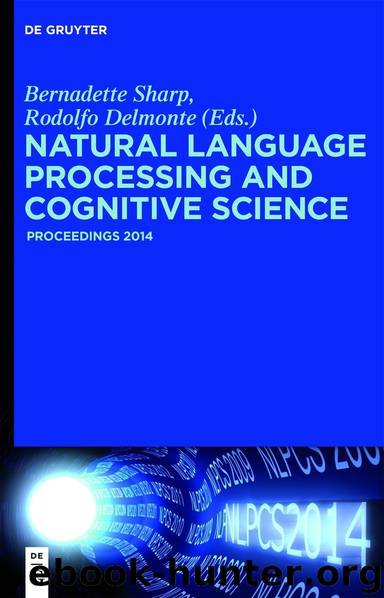Natural Language Processing and Cognitive Science: Proceedings 2014 by Sharp Bernadette Delmonte Rodolfo

Author:Sharp, Bernadette,Delmonte, Rodolfo
Language: eng
Format: epub
Publisher: De Gruyter
Published: 2015-02-23T16:00:00+00:00
4 Citation Purpose Classification and Citation Polarity Classification
The fields of citation purpose classification (function) and citation polarity classification are interesting research topics that are being explored in recent years. An introduction to an automated solution to this problem was first developed for [36] applied in 116 articles randomly chosen from annotated corpus from Computation and Language E-Print Archive24. They used a supervised technique to automatically annotate citation text using machine learning to classify 12 citation functions aggregated in four categories. This work did not include a posterior classification of unlabeled text.
[25] used a supervised probabilistic model of classification based on a dependency tree with CRFs to distinguish positive and negative polarity to a dataset formed by four corpora for sentiment detection in Japanese.
[10] used a semi-supervised automatic data annotation with an ensemble-style self-training algorithm. Classification was aspect-based with NaÃŕve Bayes as main basic technique. Citation was classified as: background, fundamental idea, technical basis and performance comparison applied over randomly selected papers from ACL ARC25.
[4] implemented an aspect-based algorithm in which each citation had a feature set inside a SVM. Corpus is processed using WEKA26 resulting in polarity citation classification.
[18] applied a faceted algorithm using Moravcsik and Murugesan annotation scheme and the Stanford ME classifier. In this approach we have a four aspects scheme and context lengths of 1, 2 and 3 sentences. Conceptual vs. operational facet asks: “Is this an idea or a tool?; organic vs. perfunctory facet distinguishes those citations that form the foundations from the citing work from more superficial citations; evolutionary vs. juxtapositional facet detects the relationship between the citing and cited papers: based on vs. alternative work; confirmative vs. negational facet, captures the completeness and correctness of the cited work according to citing work.
[24] implemented a hybrid algorithm that used discourse as a tree-model and analyzed POS as regular expressions to obtain citation relations of contrast and corroboration.
[9] obtained XML from PDF formats using PDFX and then extract citations by means of XSLT. They retrieved citation functions using citation context with CiTalO27 tool and two ontologies: CiTO2Wordnet and CiTOfunctions. Following are some of the positive, neutral and negative functions they used: agrees with, cites, cites as authority, cites a data source, cites as evidence, cites as metadata document, cites as potential solution, cites as recommended reading, cites as related, confirms, corrects, critiques, derides.
[20] used a ME-based system to train from annotated data an automatically classify functions in three categories linked to sentiment polarity: Positive (agreement or compatibility), Neutral (background), and Negative (shows weakness of cited work).
[16] implemented citation extraction algorithm through pattern matching. They detected polarity (positive, negative and neutral) with CiTalO, a software they developed using a combination of techniques of ontology learning from natural language, sentiment analysis, word sense disambiguation (with SVM), and ontology mapping. Corpus used was 18 papers published in the seventh volume of Balisage Proceedings (2011)28, about Web markup technologies.
[37] made unsupervised boot-strapping algorithm for identifying and categorizing in two categories of concepts: Techniques and Applications.
[13] established a faceted classification of citation links in networks using SVM with linear kernels.
Download
This site does not store any files on its server. We only index and link to content provided by other sites. Please contact the content providers to delete copyright contents if any and email us, we'll remove relevant links or contents immediately.
Algorithms of the Intelligent Web by Haralambos Marmanis;Dmitry Babenko(16237)
Jquery UI in Action : Master the concepts Of Jquery UI: A Step By Step Approach by ANMOL GOYAL(9389)
Test-Driven Development with Java by Alan Mellor(7737)
Data Augmentation with Python by Duc Haba(7610)
Principles of Data Fabric by Sonia Mezzetta(7380)
Learn Blender Simulations the Right Way by Stephen Pearson(7296)
Microservices with Spring Boot 3 and Spring Cloud by Magnus Larsson(7139)
Hadoop in Practice by Alex Holmes(6589)
RPA Solution Architect's Handbook by Sachin Sahgal(6519)
The Infinite Retina by Robert Scoble Irena Cronin(6218)
Big Data Analysis with Python by Ivan Marin(5937)
Life 3.0: Being Human in the Age of Artificial Intelligence by Tegmark Max(5519)
Pretrain Vision and Large Language Models in Python by Emily Webber(4897)
Infrastructure as Code for Beginners by Russ McKendrick(4654)
Functional Programming in JavaScript by Mantyla Dan(4438)
WordPress Plugin Development Cookbook by Yannick Lefebvre(4386)
The Age of Surveillance Capitalism by Shoshana Zuboff(4252)
Embracing Microservices Design by Ovais Mehboob Ahmed Khan Nabil Siddiqui and Timothy Oleson(4149)
Applied Machine Learning for Healthcare and Life Sciences Using AWS by Ujjwal Ratan(4136)
